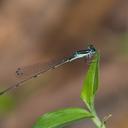Description: Males eyes and green below and black above with green post-ocular spots. Thorax green with black stripes. Abdominal segments 1-6 uniform black dorsally, pale gray to greenish laterally. Segments 3-6 have a black ring at the anterior end. Segments 7-10 cream colored. The cercus is elongate, decumbent and spinulose. Under magnification, the hook-like posteriorly directed movable process of the genital ligula are unique.
Female's eyes are greenish above, yellow below; thorax more obscurely patterned than on male. Abdomen black above sides green at base, blue on segments 3-10, black rings at ends of segments 3-7. Ovipositor prominent. Under magnification identified by rounded corners of medial lobe which are angular in those species with a supplementary inferior lobe.
Size: Male Total length: 37-38 mm; abdomen: 31 mm; hindwing: 17 mm. Female Total length: 40 mm; abdomen: 32 mm; hindwing: 20 mm.
Similar Species (US and Mexico): No other damsefly in our area with a greenish thorax and long thin abdomen with segments 7-10 cream colored. Red-tipped Swampdamsel (Leptobasis vacillans) and Lucifer Swampdamsel (Leptobasis lucifer) have red tipped abdomen.
Habitat: Shaded pools in slow flowing streams or forested ponds, all with herbaceous vegetation.
Natural History: This is primarily a Mexican species which has been recorded only in a few places in the US near the Mexico/Texas border: Hidalgo, Cameron, Dimmit, Kleberg and Brewster Counties. In Mexico it is not a common species, with records in Jalisco, Sinaloa and Oaxaca on the Pacific coast and Veracruz on the Gulf of Mexico.
Prefers shaded habitats. Males perch from near the ground to about head height in shrubs, vine tangles, and tall grass, normally over or near water. They may visit water during midday hours. Perhaps less likely to be seen when conditions are hot and dry. Females are encountered less frequently than males but may dominate locally toward the end of the season.
Distribution: Southern Texas, USA, and Mexico.
Sources:
Abbott, J. C. 2005. Dragonflies and Damselflies of Texas and the South-Central United States. Princeton University Press.344 pp.
Garrison, R.W. and N. Von Ellenrieder. 2010. Redefinition of Leptobasis Selys whit the synonymy of Chrysobasis Rácenis and description of L. mauffrayi sp nov, from Peru (Odonata: Coenagrionidae). Zootaxa 2438: 1-36.
Paulson, D. R. 2009. Dragonflies and Damselflies of the West. Princeton University Press.535 pp.
Paulson D. R. and E. Gonzalez-Soriano. 1994. Mexican Odonata. An online resource available at: https://www.pugetsound.edu/academics/academic-resources/slater-museum/biodiversity-resources/dragonflies/mexican-odonata/
